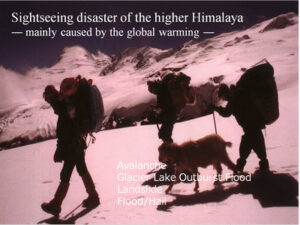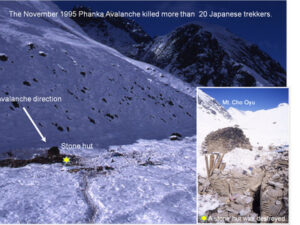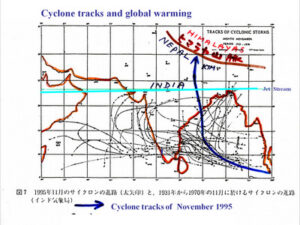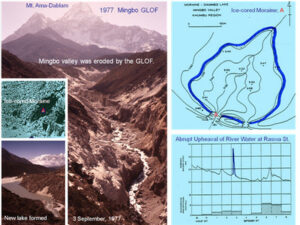2.Sightseeing disaster of the higher Himalaya in Nepal
This is a report of “Sightseeing disaster of the Higher Himalaya in Nepal” presented at the seminar; “Challenges for the promotion of Japanese Tourist in Nepal” organized by JICA Alumni Association of Nepal and held at Hotel Himalaya in Kathmandu on 29 August, 2008. Main topics of my presentation are avalanche, landslide and glacier lake outburst flood (GLOF) caused by the global warming that the trekkers are requested to take careful attentions on environmental changes of the Nepal Himalaya for preventing such kinds of natural disaster.
It was November 1995 when the mighty cyclone hit the Himalayas and caused the heavy snowfall which thickness was more than 1.5m in the northern part of Khumbu region, East Nepal. There were more than twenty Japanese trekkers staying at stone hut located near the mountain slope of Phanka village near Ghokyo, Khumbu and the avalanche destroyed the stone hut and all of Japanese trekkers lost their lives under the stone wall. It was unusual that a cyclone came up to the northern region of Kolkata which Latitude is 25 degrees north where the Jet Stream usually stays in the post monsoon season and blocks the cyclone coming up north to the Himalayas. However, the Jet Stream moved toward the central part of Nepal in November 1995 due to the global warming and the cyclone easily came up and reached the Himalayas. We must be very careful of this kind of the winter avalanches.
There are mainly two types of landslide phenomena in Nepal. One is the higher type affecting the Higher Himalaya which altitude is more than 4000 m asl. and the glacial conditions are prevailing and the landslides are mainly caused by the melting of glacier and snow due to the recent global warming, and the other is the lower type occurring below 4000 m asl. in the Lower Himalaya where villages are located and it has been known as an environmental issue of the anthropological activities.
Nepal Himalaya locates in the southern margin of Tibetan plateau where the glaciers have been retreating since the 1980’s. Analyses of recent mean temperature data in Nepal revealed warming trends ranging from 0.06 ℃ to 0.12 ℃ yr-1 after 1977 and it indicated to be 2-4 times higher rates of warming in the Himalayas as compared to the global average. The GLOF of the Nepal Himalayas was firstly observed in the Mingbo valley of Khumbu region near Mt. Ama-Dablam in 1977 (1), and the GLOFs of Langmoche in 1985 and Savoy in 1999 occurred recently in the same region. They caused serious disasters that destroyed the down-stream villages, bridges, and even hydro-power station. Glacial lakes have developed in the Himalayas and the Tibetan Plateau due to the melting of glacier and snow by an influence of the global warming and the GLOF has occurred once every ten years in Khumbu region due to the increasing glacial lake and the instable dammed-up moraine that the trekkers are requested to take careful attentions when they visit the Higher Himalaya.
(1) NEPAL CASE STUDY: CATASTROPHIC FLOODS. 1985, TECHNIQUES FOR PREDICTION OF RUNOFF FROM GLACIERIZED AREAS, INTERNATIONAL ASSOCIATION OF HYDROLOGICAL SCIENCES, 149, 125-130.


















